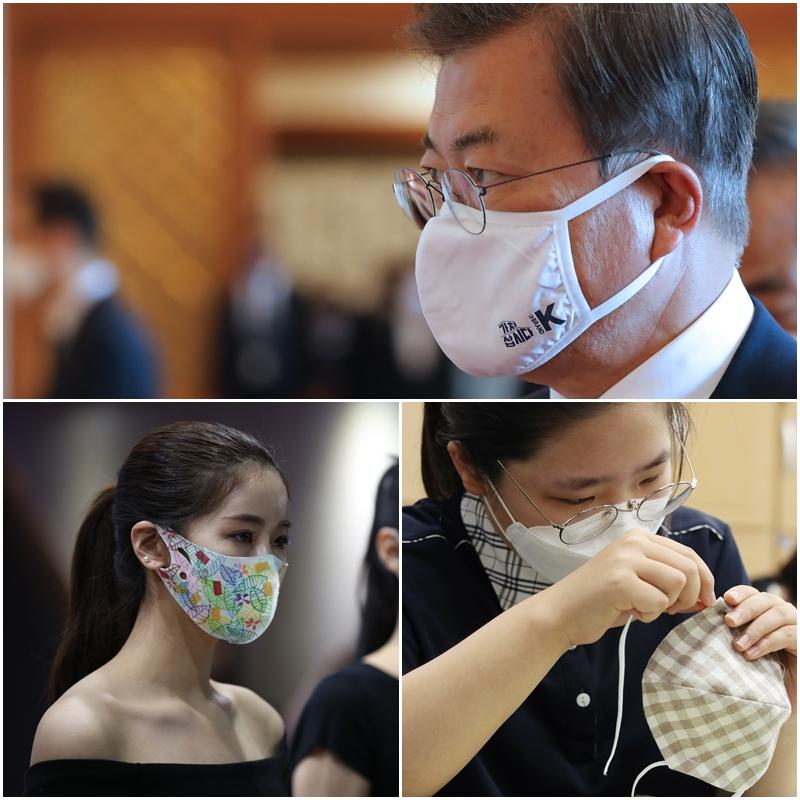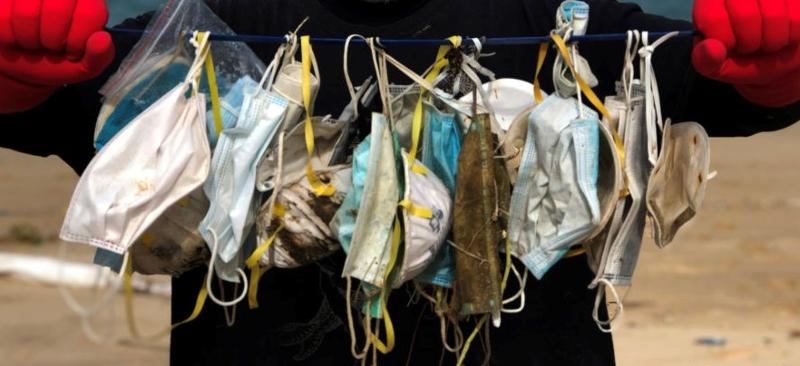
As protective masks are now part of daily life, a variety of types and materials are available and new items come out every day. (From left to clockwise) Various straps designed to attach a mask to a user's face are on sale; Daegu FC players wear masks inscribed with their team logo; and an anti-bacterial pouch protects a mask from droplets and food stains. (Lee Kyung Mi, Daegu FC).
By Lee Kyoung Mi and Yoon Sojung
As the COVID-19 pandemic lingers, face masks, the strongest vaccine to the disease so far, have evolved in type, color and materials to offer a wider variety. New related items are also being introduced to reduce the discomfort of mask users.
Wider variety of shapes, colors, types offer more consumer options
In the early stage of COVID-19, most masks were rectangular shaped and came in either white or black. Nowadays, a wider variety of mask colors and shapes are available. Some of them are shaped like a bird's beak, a rectangle or even an octagon. By type, customers can choose from not only medical masks classified as KF94 and KF80 but also droplet-blocking models that enable easier breathing.
The materials used to make the masks also vary. Those who care about the environment prefer cotton masks, while those who eager to beat the summer heat, users opt for those made of materials with a cooling effect such as aero cool fabric or artificial silk.
Masks with a clear panel in the mouth area are also available. This type is hearing impaired friendly designed for those who communicate by reading facial expressions and lips.
One model has an electric filter attached and another comes with a lid so that the user can drink or talk easily with the mask on.

People can express themselves and their personalities through their masks. (Top to clockwise) President Moon Jae-in wears a mask with the logo of "Brand K," the government’s support project for small and medium companies; a volunteer makes a cotton mask for a mask-sharing charity campaign; and a model sports a mask with a vivid pattern. (Yonhap News)
Tool for expressing self and personality
Masks can be also used to convey a message or promote something. For example, the National Fiscal Strategy Meeting on May 25 at Cheong Wa Dae saw President Moon Jae-in wear a mask with the logo of "Brand K" to promote a support and marketing program for small and medium companies. He had from April 9 started to wear cotton masks inscribed with the slogan "Cheer up, Republic of Korea."
Jose Manuel Ferreira de Morais, head coach of the Korean pro soccer team Jeonbuk Hyundai Motors, attracted media attention by wearing a mask inscribed with his team logo throughout a game and at the post-match news conference. Masks with the logo of the Korean national soccer team launched last month by the Korea Football Association sold out within five hours.
Some Koreans decorate or put stickers with the names of their favorite singers or stars on their masks as a means of self-expression. Others make masks inscribed with their names to express their personalities.
New masks designed to reduce discomfort
Users have complained of pain, especially around the ears, when wearing masks for a long time. Many wonder what to do with their masks when having a meal, and many new models have appeared to rectify this problem.
One of the bestselling items in this category is a strap allowing users to take their masks off for a few minutes. Just tie the mask's strings with the strap to ensure not losing the mask.
Another hot accessory is a pouch for storing a mask and keeping it free from droplets or food stains. Others include equipment to reduce pain in the back of the ears for those wearing masks for a long time, as well as mask chains or rubber bands that help users wear masks as close as possible to their faces.
km137426@korea.kr

Masks are now an everyday item that must be properly worn but no less important is discarding them properly to prevent environmental pollution and secondary infection. The photo above is of masks discovered at a beach. (Oceans Asia)
By Xu Aiying and Lee Jihae
The skyrocketing production of protective masks has made their proper disposal a serious issue.
The Ministry of Food and Drug Safety said the production of non-medical masks from Aug. 17 to Sept. 23 is estimated at 251.2 million units. As masks are a daily necessity in the era of COVID-19, about 200 million masks are produced every week.
The main material in disposable masks is plastic, which causes environmental pollution if littered on streets and oceanic pollution if carried away by the sea.
What happens if someone touches a mask worn by a person infected with COVID-19? Viruses on the mask's surface can last as briefly as hours and as long as days, so masks can definitely spread infection.
So what is the proper method of discarding masks to protect the environment while simultaneously prevent secondary infection?
The ministry recommends touching only the mask's strings that attach to the ears when taking the mask off. Then fold it inwards, wrap the whole mask with the strings, spray it with disinfectant and throw it away in a trash can. If no disinfectant is available, make sure the mask never comes out of the can. Because of the possibility of touching the contaminated part of the mask, wash your hands promptly after taking the mask off.
The Ministry of Environment has recycling guidelines saying all masks, regardless of material like paper, non-woven fabric or cotton, are regular non-recyclable waste.
All masks worn by those infected with COVID-19 or those in self-quarantine must be categorized as medical waste and properly thrown away. Such masks must be kept completely sealed in the special bags given by public health centers. A staff member from a center will visit the person in quarantine and collect the bags.
xuaiy@korea.kr